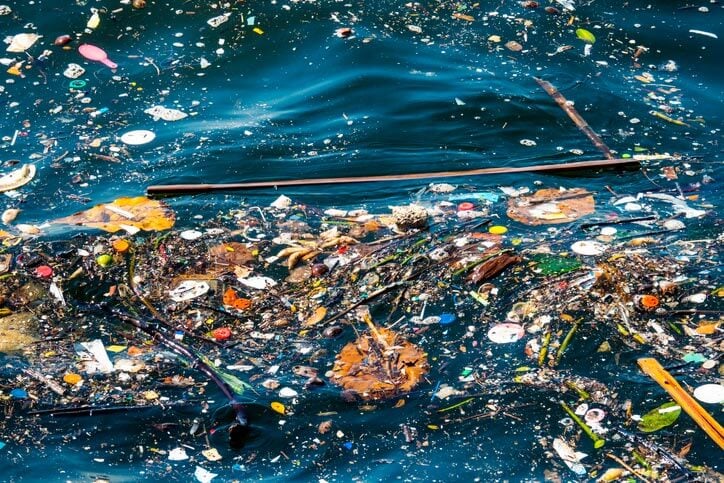Plastic has long been considered a “miracle material,” making the goods and products that power our world and make our lives easier, more effective, and affordable. Unfortunately, how we dispose of plastic is nothing short of a global crisis.
Most plastic is designed to be used once and then discarded. As a result, plastic pollution is everywhere—from Everest to Antarctica, in our soil and even in newborn babies.
It is estimated that every year, nations worldwide produce around 350 million metric tons of plastic waste. Nearly five percent of that plastic gets swept into waterways, entering our oceans as 14 million tons of plastic waste each year, and the trends are alarming.
In fact, plastic flows into the ocean are expected to triple by 2040. By 2050, the World Economic Forum estimates that plastic pollution could outweigh all the fish in the sea.
Plastic pollution has had a devastating effect on marine life, not to mention coastal livelihoods and tourism. Meanwhile, the effects of microplastics on human health and food safety are just beginning to unfold.
Companies, too, are feeling the effects of a sea change in sentiment toward single-use plastics, as more consumers opt for environmentally-friendly goods and products.
How the Circular Economy Helps Reduce Ocean Plastics
In response to the growing devastation of plastics pollution and advocacy of the United Nations Environmental Assembly (UNEA), 175 countries voted in March 2022 to develop a legally-binding global plastics agreement by 2024.
This has been an arduous task and process to date, with one interval meeting of the International Negotiating Committee (INC) already making some progress. But as the clock ticks down, the UN, policymakers, corporate leaders, and countless stakeholders are under pressure to put forward a strong global treaty that addresses not only the environmental and social externalities and considerations of the overproduction, use, and pollution of plastics, but also the governance implications as well.
As the INC prepares to convene again in Paris, France, from May 29 – June 2, 2023, to move forward on decisions regarding the structure and provisions of the future instrument, one thing is clear. Most proponents believe that a global plastics agreement that can move beyond rhetorical commitments to effectuate real, meaningful, and transformative change must address the full lifecycle of plastic, from fossil fuels extraction to end-of-life waste.
The UNEA cites collaboration across sectors—between governments, companies, foundations, NGOs, and others—as a core factor in achieving significant, sustainable impact. But what solutions will these stakeholders implement to turn the tide on ocean plastics?
To solve a pervasive global problem like ocean plastic pollution, stakeholders must design and deploy entirely new systems for plastics management.
The circular economy, which builds upon the principles of reduction, reuse, and recycling (in that order), is a critical framework for creating systems needed for breakpoint change and greater, long-lasting sustainable impact.
Published by the Secretariat of the INC last month, an advance version of a paper that will inform deliberations at the second session of the INC in March outlines elements that could potentially be included in an international plastics treaty. The options are “based on a comprehensive approach that addresses the full life cycle of plastics,” and indicate several core obligations gleaned from member States’ views and submissions, and include inter alia:
- Phasing out and/or reducing the supply of, demand for, and use of primary plastic polymers;
- Banning, phasing out, and/or reducing the use of problematic and avoidable plastic products;
- Banning, phasing out, and/or reducing the production, consumption, and use of chemicals and polymers of concern;
- Reducing microplastics;
- Strengthening waste management;
- Fostering design for circularity;
- Encouraging “reduce, reuse and repair” of plastic products and packaging;
- Improving the integrity of necessary plastics to make them safer and more durable for longer-use;
- Ensuring plastic products are easier to break down and recycle into something else that is usable;
- Promoting the use of safe and sustainable alternatives and substitutes; and
- Eliminating the release and emission of plastics to water, soil, and air.
Learn How Companies Can Lead the Transition to a Circular Economy
5 Ways to Combat Ocean Plastic Using Circular Economy Principles
By adopting a circular economy framework to solve plastic pollution, we can staunch the flow of plastic into our rivers and oceans and harness what is already there through innovation.
Below are five best practices for how stakeholders can work together to apply circular economy principles to ocean plastics pollution.
1. Stop Plastics Generation at the Source
To date, most ocean plastic initiatives have prioritized recycling. It’s an important short-term step to put a dent in the islands of floating trash and near-shore pollution that are already wreaking havoc on sea life and coastal communities.
Still, recycling ocean plastics without a plan to stop new plastic from flowing into the ocean is no different than bailing out a sinking ship. Recycling is a zero sum game (at best) if not paired with a plan to staunch the constant influx of new plastics into the sea.
To address plastics pollution on a more fundamental level, companies like Alagramo are designing reusable, affordable packaging for common household goods in place of single-use plastics. The innovation requires consumers to take empty bottles back to filling stations rather than recycling or throwing away.
However, companies entice this behavior change by reducing the purchase price of detergents, soaps, and other everyday items. The model also avoids the use of fossil fuels and carbon dioxide emissions associated with the creation of new, single-use plastics.
2. If You Can't Eliminate Ocean Plastics, Reduce How Far They Must Travel
Why don’t more companies use recycled plastics in their goods? Because while some consumers will pay a premium for the greener approach, most cannot—and recycled plastics are currently more expensive to recover than sourcing new, virgin plastic. Why is recycled plastic more expensive? Because the current recycling market isn’t cost-effective.
Our current recycling systems require a massive capital investment in material recovery facilities (MRFs). Facilities owners must then sell enough reusable plastic to make a return on their investment. That’s hard to achieve when you must transport a high percentage of single-use plastics to a recycling facility, only to throw them away.
The effort wastes gas and the carrying capacity of transport trucks while increasing scope 3 greenhouse gas emissions and the chance for pollution from single-use plastics to leach into the environment.
Distributed recycling infrastructure shortens the distance that waste needs to travel before it can be transformed into usable inputs for new packaging and products. In one example, PepsiCo is working with Closed Loop partners to create smaller, modular recycling centers across the U.S. to increase access to recycling in areas with limited access and reduce the cost of transporting unusable plastics waste.
Learn Opportunities and Challenges in Protecting the World's Oceans (Q&A)
3. Integrate Human-Centered Design into Waste Reduction Solutions
Waste reduction strategies are meaningless if consumers find them harder to use than the conventional approach. Human-centered design principles help you embrace the mindset of your customers to design plastic-free solutions that are easy to find, use, and pay for.
Take Apeel. The company recently partnered with WalMart to replace the plastic packaging on English cucumbers. Instead, Apeel uses vegetable waste from rinds and peels to create a non-plastic cover for produce to keep it just as fresh, but without the single-use plastic packaging.
At WalMart, the move eradicated two grams of single-use plastic—the equivalent of 5 plastic straws—with each cucumber sold. In Germany, use of Apeel’s products also reduced store waste and improved sales by 20 percent.
4. Advocate for National Regulation and Public Spending on Plastics Reform
It’s no secret that companies tend to come up with the most innovative products. Increasingly, the development sector—international donors, foundations, and NGOs—is prioritizing private sector engagement and partnership to offset the cost of innovation that helps meet sustainable development goals (SDGs).
Still, given the scale and reach of the plastics pollution crisis, governments must also enact policy change and contribute financial support where possible to achieve truly transformational results.
Government investment and reform is one reason why the European Union is leading on circular economy indicators.
- For instance, France was the first to ban the disposal of unsold non-food products.
- Meanwhile, the Dutch have set an agenda to become a fully circular economy by 2050, and are supporting the transition through a series of action agendas.
- And the Italian government has established a public investment fund for the circular economy and other sustainability projects and measures. The fund designates €600 million to create or strengthen local supply chains to use raw materials more efficiently.
5. Collaborate Across Sectors to Align Efforts and Resources and Drive Systems-Level Change
The vision of a truly circular economy is one that creates no waste; one that can use and regenerate raw materials indefinitely. While that vision is only attainable when all sectors and countries are on board, incremental progress can make an outsized impact if major stakeholders work together to coordinate and support each other’s efforts.
Implicit in our suggestions for combatting ocean plastic is an ethos of cross-sector collaboration. The public and private sectors have complementary skill sets and resources that allow them to achieve more by working together.
With respect to ocean plastics, multi-stakeholder initiatives like the Platform for Accelerating the Circular Economy (PACE) provide support for public-private dialogue and collaboration. Becoming a member allows organizations to help set the stage for the next phase of progress toward cleaner oceans and more sustainable economies.
Take the Next Step Toward Sustainable Impact
By moving beyond simple recycling into more innovative approaches that can tackle plastic waste at a systemic level, we stand a chance of reducing and ultimately eliminating plastic waste in our oceans.
Through strong cross-sector collaboration and innovative, inclusive design, stakeholders can maximize resources and make a far greater impact.
For more on how your organization can join others in making the shift away from plastics pollution, contact us. Of interest, we are also hosting in fall 2023 a roundtable focused on plastics cirularity. If you are a sustainability leader engaged in initiatives for companies with substantial AG supply chains, and plastics circularity is a challenge for your ESG, Sustainble Impact roadmaps, and other sustainability goals, let us know if you are interested in joining us as part of this planned forum on the criticality of addressing plastics and packaging.
Editor’s Note: This post has been updated for accuracy and current best practices.



